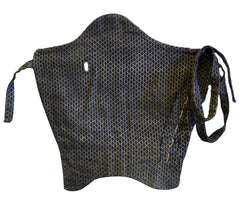An Edo Komon Kyahan #1: 19th Century Gaiter
ca. mid nineteenth century
13 1/2" x 14 1/2", 34 cm x 37 cm
In traditional Japanese clothing, especially those used for travel, gaiters, or shin protectors would be worn to protect the legs from abrasion and dirt. These gaiters, or kyahan, were worn by all classes of people, from ragged ones made of recycled cloth used by farmers to more elaborate ones worn by people of means, as is this example.
The kyahan is hand stitched from hand spun, hand woven cotton which has been dyed using the katazome or stencil resist dyed method. The small pattern, known as Edo komon, was popular at the end of the Edo period, during the late 18th through the 19th century. One of the mandates of sumptuary laws was to restrict certain classes of people from wearing certain types of cloth, colors and patterns. Most Japanese citizens were allowed to wear only discreet patterns in muted colors, hence the small figured pattern shown on this kyahan.
The interlocking zigzag motif shown here is an abstracted pine bark motif, a traditional Japanese pattern called matsukawabishi.
On the back of this kyahan you will see the slubby, undyed white cotton is fitted with closures, possibly whale bone; the bottom edge of the kyahan is stained with dirt from years of use.
A beautiful object from old Japan with a really lovely and good quality cotton cloth as its base.

